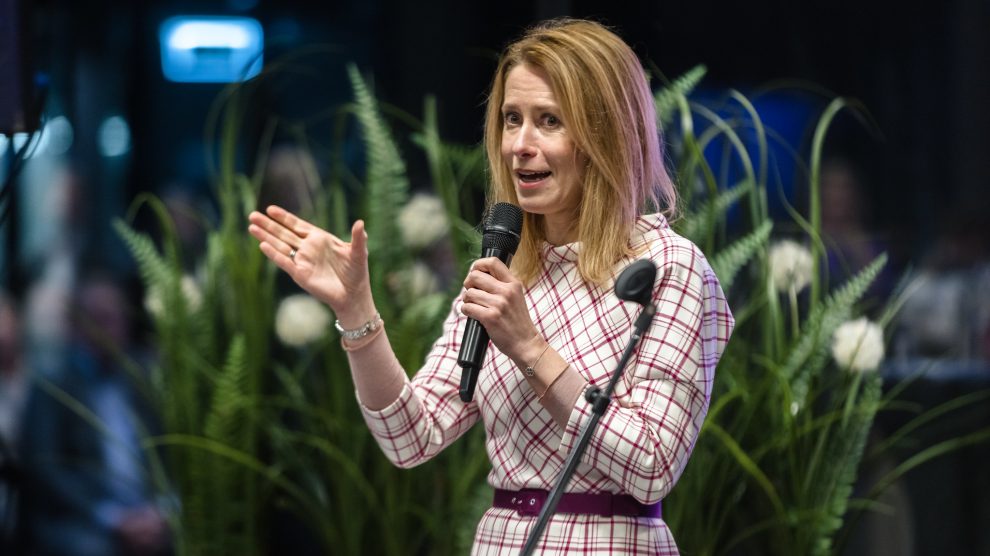Internet voting is already underway in Estonia’s parliamentary elections. Prime Minister Kaja Kallas’s Reform Party seems set to again win the most votes as national security and cost of living dominate discussions, but a new party could re-shuffle the governing coalition.
At least 24 per cent of Estonia’s approximately one million eligible voters have already cast their vote in a March 5 parliamentary election, thanks to early voting.
As of March 2, almost three-quarters of votes already cast made use of internet voting which allows Estonians to vote on their computers using an ID card and PIN codes for security.
- Estonia’s collaborative approach pays dividends for start-ups
- Why Estonian parents are winning at entrepreneurship
- Creating an ecosystem that works for all: FDI in emerging Europe
If early voters change their minds, they can still cast a paper ballot on election day to override their previous electronic vote. Researchers at the Tallinn University of Technology have calculated that electronic voting costs half as much as conventional paper voting in administrative expenses.
Estonians have been able to use i-voting since 2005. In the last parliamentary elections in 2019, roughly 44 per cent of Estonian voters made use of the technology.
However, a lot has changed in Estonian politics since 2019.
The story so far
The 2019 election results allowed then prime minister Jüri Ratas of the populist centre-left Centre Party to form another cabinet. The Centre Party had a “joint protocol on cooperation” with Vladimir Putin’s United Russia party at the time, and Ratas’s party remains popular among Estonia’s ethnic Russian minority.
However, the Centre Party did not secure a majority and was only able to form a governing coalition by partnering with the conservative Christian party, Isamaa, and reversing a previous pledge not to work with the far-right, nationalist Conservative People’s Party (EKRE).
Ratas’s cabinet was plagued by scandals concerning EKRE ministers’ domestic violence, sexism, use of white supremacist symbols, and comments alleging the results of the United States 2020 presidential election were “rigged”. Ratas resigned as prime minister in January 2021 over a corruption scandal concerning alleged influence peddling and bribery by Centre party leaders.
Kaja Kallas’s Reform party—a centre-right, liberal outfit also known as the ‘Squirrel party’ that receives support from young professionals and women—formed a new governing coalition with the Centre party. Kallas, the daughter of former prime minister Siim Kallas, became Estonia’s first female prime minister. Isamaa and EKRE joined the opposition.
The Reform-Centre coalition lasted 16 months. At that time, Russia invaded Ukraine and the Centre party annulled its agreement with United Russia. As the Reform party took a staunchly anti-Russia stance, the coalition partners clashed over whether Russian-language schools in Estonia should be entirely transitioned to the Estonian language.
Rumours circulated that the Centre party was having secret talks with EKRE to reform their old coalition, and Kallas kicked the Centre party out of the coalition in June 2022. Reform then formed a new coalition with the Social Democrats and Isamaa. In December 2022, the new governing coalition duly passed a law to transition all Russian-language schools to Estonian.

New elections and a new party
There is consensus across Estonia’s major political parties that the country must strongly stand with its NATO allies and Ukraine in the face of Russian aggression. Estonia has devoted the greatest share of its GDP to aiding Ukraine of any country in the world—a whopping 1.07 per cent.
The war in Ukraine has nevertheless contributed to a cost of living crisis in Estonia, and this election’s campaigns have been dominated by discussion of energy policy and inflation.
POLITICO’s polling aggregate shows Reform receiving roughly 30 per cent support with EKRE in second place at 19 per cent and Centre in third with 16 per cent.
Professor Mari-Liis Jakobson from Tallinn University told EuroNews that, “Kallas is relatively popular as a prime minister, she is currently the most popular candidate for the PM position, but I wouldn’t say that she’s unanimously liked”.
Parties must reach a five per cent threshold of votes to receive seats in parliament. In 2019, the Estonia 200 party fell just short of that threshold, but they now appear to be fourth in the polls, behind Centre and ahead of the Social Democrats and Isamaa.
Estonia 200 is a progressive party that began as an attempt to bring together both Estonian and Russian speakers tired of language politics. They now call themselves “Estonian-minded” and emphasise their commitment to preserving the Estonian language.
Estonia 200, the Social Democrats, and Isamaa have all ruled out forming a coalition with EKRE—despite Isamaa previously serving alongside them in the Ratas coalition. The exact vote margin will determine whether Reform is able to form a coalition with Estonia 200 and the Social Democrats or whether Centre and EKRE will partner again.
Photo: Jürgen Randma
Unlike many news and information platforms, Emerging Europe is free to read, and always will be. There is no paywall here. We are independent, not affiliated with nor representing any political party or business organisation. We want the very best for emerging Europe, nothing more, nothing less. Your support will help us continue to spread the word about this amazing region.
You can contribute here. Thank you.



Add Comment